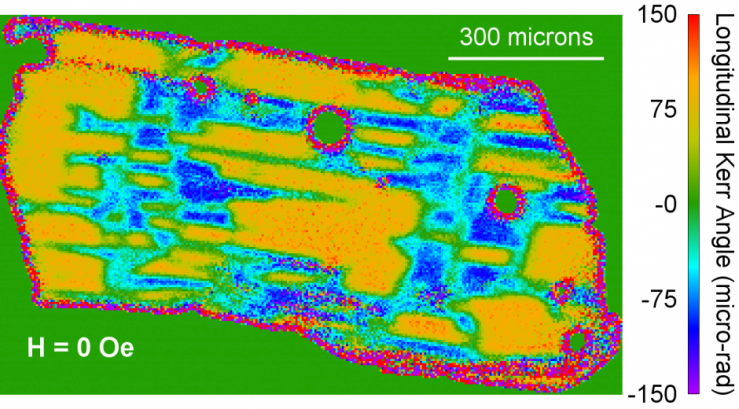Spatial Map of Magnetization with Sagnac-Interferometry-Based Microscopy

The groups of Professor Zhu and Professor Taufour recently demonstrated a Sagnac-interferometry-based magneto-optical microscope for imaging magnetic domains of novel crystalline materials at low temperature (https://doi.org/10.1063/5.0042574).
Ferro-magnetic states are important phases of solid materials. In such a state, electron spins in a solid become ordered spontaneously and lead to a non-zero magnetization. In a real crystalline sample, the orientation and magnitude of such a magnetization and the transition temperature vary from one location to another for intrinsic and extrinsic reasons. To characterize intrinsic magnetic properties of a sample free of effects due to spatial inhomogeneity, it is often desirable that one measures magnetic properties of a sample in a spatially resolved manner using magnetization-sensitive microscopes.
The group of Professor Zhu recently developed magneto-optical microscopes based on Sagnac effects in magnetic samples on optical reflection and transmission (https://doi.org/10.1063/1.4990669). The essence of such an effect is that the phase change of an optical beam upon reflection from or transmission through a magnetized sample alters sign when the direction of propagation is reversed. The Sagnac interferometry measures such a time-reversal symmetry breaking effect. By focusing the optical beam to a diffraction-limited spot, a Sagnac-interferometry-based scanning microscope yields a spatially resolved map of sample magnetization. Magneto-optical microscopes developed in Professor Zhu’s group measure both in-plane and out-of-plane magnetization components so that the vector nature is fully characterized. To illustrate this new magneto-optical microscope, groups of Professor Zhu and Professor Taufour imaged magnetic domains on the a-c plane of a ferromagnetic LaCrGe3 crystal at 77 K, below its Curie temperature at 86 K. LaCrGe3 exhibits a rich phase diagram at low temperatures and under high pressures. The microscope enables them to determine in-plane orientations of magnetic domains.
Published: May 26, 2021, 4:17 pm
